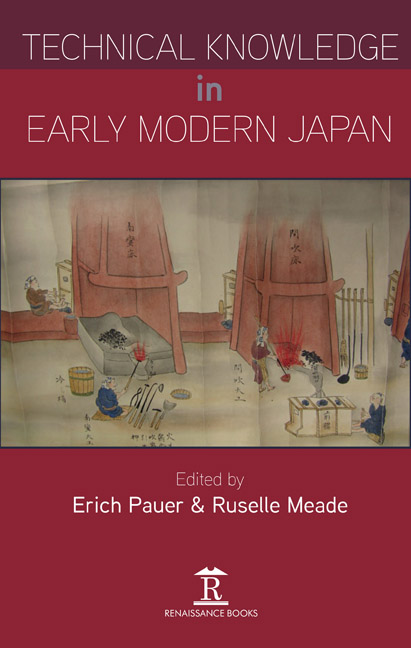Book contents
- Frontmatter
- Contents
- Acknowledgements
- Introduction: Remarks on the History of Technology in Japan
- 1 Production Techniques in Early Modern Japan as seen through ‘Famous Products of Japan from Mountain and Sea, Illustrated’ (Nippon sankai meisan zue, 1799)
- 2 Vehicles of Knowledge: Japanese Technical Drawings in the Pre-modern Era, 1600–1868
- 3 Dissemination of Knowledge and Technology: The Extensive Range of Exhibitions in Japan in the Eighteenth and Nineteenth Centuries
- 4 Knowledge on Mining and Smelting and Its Dissemination in the Edo Period
- 5 Tanaka Hisashige and His Myriad Year Clock: Its Technological Characteristics and Historical Background
- 6 A Statistical Analysis of Tōkyō Meikō Kagami (with a Focus on Highly Skilled Metalwork Craftsmen)
- 7 Boiler Manufacture in Late-nineteenth Century Japan: From First Beginnings to Nationwide Expansion
- Appendix: Selected Sources on the Japanese History of Technology (especially on series)
- List of Contributors
- Index
Appendix: Selected Sources on the Japanese History of Technology (especially on series)
Published online by Cambridge University Press: 30 April 2022
- Frontmatter
- Contents
- Acknowledgements
- Introduction: Remarks on the History of Technology in Japan
- 1 Production Techniques in Early Modern Japan as seen through ‘Famous Products of Japan from Mountain and Sea, Illustrated’ (Nippon sankai meisan zue, 1799)
- 2 Vehicles of Knowledge: Japanese Technical Drawings in the Pre-modern Era, 1600–1868
- 3 Dissemination of Knowledge and Technology: The Extensive Range of Exhibitions in Japan in the Eighteenth and Nineteenth Centuries
- 4 Knowledge on Mining and Smelting and Its Dissemination in the Edo Period
- 5 Tanaka Hisashige and His Myriad Year Clock: Its Technological Characteristics and Historical Background
- 6 A Statistical Analysis of Tōkyō Meikō Kagami (with a Focus on Highly Skilled Metalwork Craftsmen)
- 7 Boiler Manufacture in Late-nineteenth Century Japan: From First Beginnings to Nationwide Expansion
- Appendix: Selected Sources on the Japanese History of Technology (especially on series)
- List of Contributors
- Index
Summary
INTRODUCTION
AS AN APPENDIX to the short introduction at the beginning of this volume, a few selected writings on the history of science and technology, which are important sources for understanding Japan's technological development, are discussed below. Some of them have already been mentioned in the introduction.
EARLY BEGINNING
A process that we can observe, not only among European countries but also in Japan, is that it was engineers (in most witnessed cases civil engineers) who – well aware of their importance in a newly industrialized country – first perceived themselves as a special (professional) group and became active as such. In Japan, this particularly applied to graduates of the Imperial College of Engineering (Kōbu daigakkō). They already founded their first ‘association’ in 1879 under the name Kōgakkai (Federation of Engineers) and began to publish their own journal named Kōgakkai-shi (Journal of the Federation of Engineers) as early as 1881. The Kōgakkai is regarded as the predecessor of the Doboku gakkai (Federation of Civil Engineers ), which was founded in 1914.
In the Meiji period, civil engineers were not only numerically the strongest group of engineers, but they were also the ones who very early on took actions against what they perceived as their negative reputation in society. In contrast to this negative attitude, they believed they were rendering important services to society. In order to highlight the importance of engineers and make their merits more widely known, they turned to the history of their profession and began to describe their achievements for the country in a series of historical contributions, written by civil engineers. The series, which has so far received little attention in academic circles, started in 1914 in the first issue of the journal Kōgaku(Engineering). The 32 contributions dealt with topics like the construction of the castle in Nagoya, the history of bridge building, the construction of the famous silver pavilion in Kyōto, the casting of the Great Buddha in Nara, the river regulation of Katō Kiyomasa, dam construction, port construction, water supply or construction of fortifications. The vast majority of the contributions focused on Japan; only a few were dedicated to historically significant construction works in other countries.
- Type
- Chapter
- Information
- Technical Knowledge in Early Modern Japan , pp. 181 - 186Publisher: Amsterdam University PressPrint publication year: 2020



